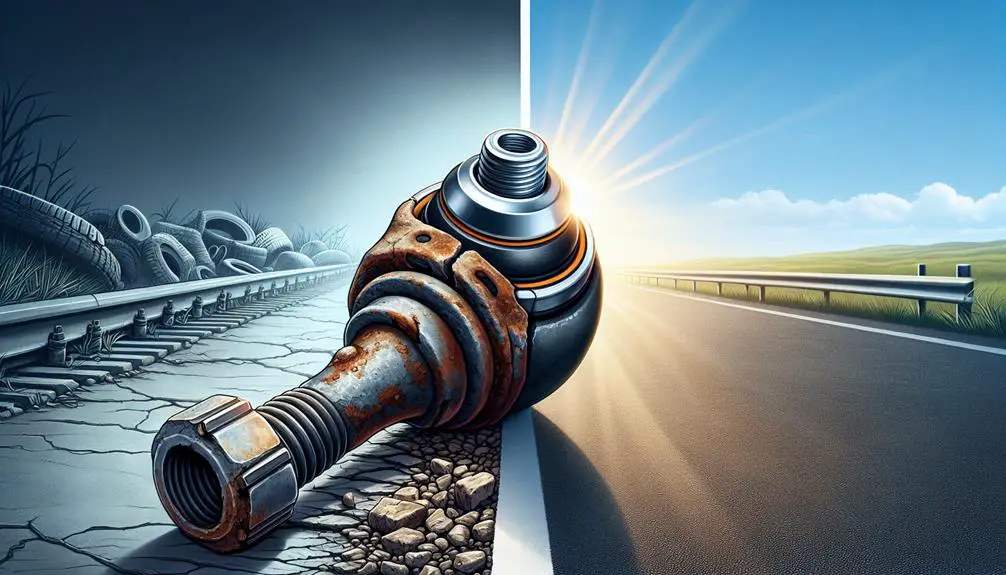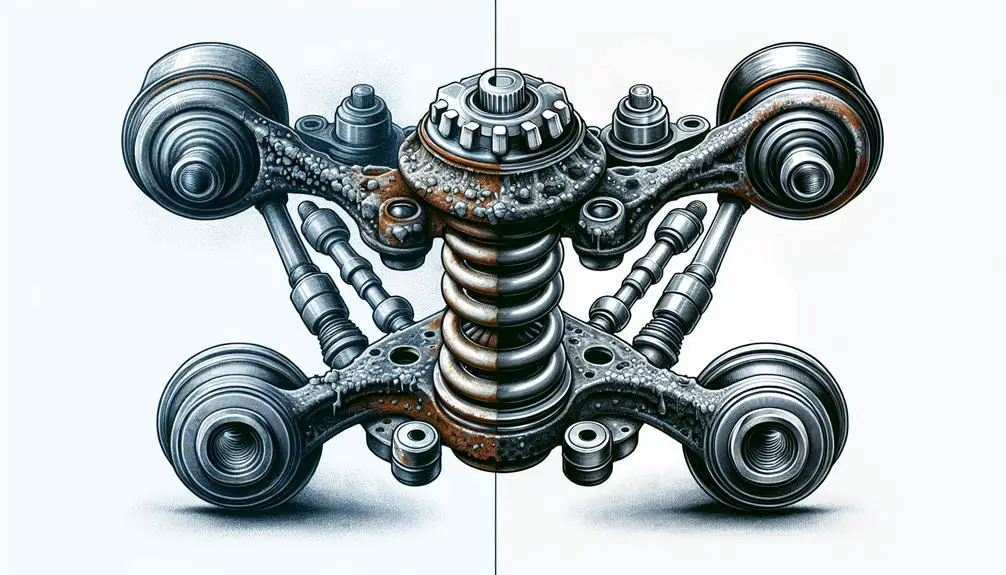Yes, new ball joints make a significant difference.
Bouncing down the backroads or cruising city streets, you've likely pondered the performance of your vehicle's pivotal parts, particularly the ball joints. These vital components guarantee smooth steering and stable suspension, but when they wear down, you're in for a bumpy ride.
If you're noticing uneven tire wear, wandering steering, or hearing unsettling noises during turns, it might be time to contemplate an upgrade. New ball joints can transform your driving experience.
Stick around as we investigate the ins and outs, offering insights that might just sway your decision.
Understanding Ball Joints

Before plunging into their impact, it's critical to comprehend what ball joints are and how they function in your vehicle. These pivotal components act like the hip joint in the human body, allowing for smooth and controlled movement in your car's suspension system. They connect the steering knuckles to the control arms, enabling your wheels to move up and down and turn left or right.
You'll find ball joints in almost every vehicle, playing a crucial role in both the suspension and steering systems. They're designed to bear significant loads while providing a pivot point for the steering and suspension to move. This dual functionality guarantees that you can steer your vehicle while it absorbs the bumps and dips of the road, maintaining a comfortable ride.
The durability of a ball joint depends on its design—sealed or serviceable. Sealed ball joints are lubricated for life, requiring no maintenance but needing replacement once worn out. On the other hand, serviceable ball joints can be lubricated periodically, potentially extending their lifespan. However, both types are subject to wear and tear owing to their constant use and the stress placed upon them by the vehicle's weight and road conditions.
Comprehending these basics highlights the significance of ball joints in your car's overall performance and safety. Without them, your control over the vehicle would be compromised, leading to a rough ride and potentially, a hazardous driving situation.
Signs of Worn Ball Joints
Comprehending the role of ball joints sets the stage for recognizing when they're starting to wear out. These pivotal components ensure your car's wheels pivot and turn smoothly. If you're noticing unusual handling or noises, it might be time to check them. Knowing the tell-tale signs can save you from a potential breakdown or expensive repairs down the line.
First, one of the most obvious signs is unusual noises from your car's suspension. If you're hearing a clunking or squeaking sound, especially when you're making turns or driving over bumps, it's likely your ball joints are crying out for attention. Second, if your steering feels unusually loose or unresponsive, it might indicate that your ball joints are wearing out. Lastly, uneven tire wear can also signal bad ball joints, as they're essential in keeping your tires evenly on the road.
| Sign | Possible Cause | Immediate Action Required |
|---|---|---|
| Clunking noises | Worn ball joints | Inspection & replacement |
| Loose steering | Degradation of joints | Professional assessment |
| Uneven tire wear | Misalignment | Check and replace joints |
Ignoring these signs can lead to more significant problems, including loss of control of your vehicle, which can be dangerous. It's crucial to act promptly when you notice these symptoms. While it's tempting to postpone maintenance, understanding and addressing the signs of worn ball joints will ensure your vehicle remains safe and reliable.
Benefits of New Ball Joints

Replacing worn ball joints with new ones can greatly improve your vehicle's handling and safety. These important components act as the pivot between your vehicle's wheels and suspension, allowing for smooth steering and control. When they're fresh and functional, you'll notice a significant improvement in the way your car responds to your steering inputs. This means you can navigate turns and maintain stability with newfound confidence.
You'll also experience a smoother ride. New ball joints eliminate that unsettling rattling and clunking noise you've grown accustomed to, making your travels quieter and more enjoyable. They work to absorb the road's imperfections, cushioning you against bumps and potholes. This not only adds to your comfort but reduces wear on other vehicle components, saving you money in the long run.
Moreover, updating your ball joints can extend the life of your tires. Worn ball joints lead to uneven tire wear, forcing you to replace them more frequently than you should. With new ball joints, your tires maintain the best contact with the road, ensuring even wear and prolonging their lifespan.
Installation Process Explained
Installing new ball joints might seem challenging, but it's a straightforward process once you understand the steps involved. Initially, you'll need to safely lift your vehicle and remove the wheel to access the ball joint. Make sure you're working on a stable, flat surface to prevent any accidents.
Next, you'll have to detach the brake components and the wheel hub to reach the ball joint. It's important you keep track of all the parts and where they belong. A good tip is to take pictures or notes during disassembly to aid in reassembly later.
Once you've exposed the ball joint, inspect it and its surroundings. If you're dealing with a press-fit ball joint, you'll need a ball joint press tool. This tool helps you remove the old joint and install the new one without causing damage to other components. For bolted ball joints, it's simpler; you just unbolt the old one and bolt on the new one, making sure to torque the bolts to the manufacturer's specifications.
After installing the new ball joint, reassemble everything in reverse order. Don't forget to reattach the brake components and wheel hub before mounting the wheel back on. It's also a good idea to get a professional wheel alignment done after the installation. This ensures your vehicle's suspension is properly aligned, preventing uneven tire wear and ensuring your ride is smooth and safe.
Maintenance Tips

After you've successfully installed your new ball joints, it's important to keep them in top condition with regular maintenance. Remember, your vehicle's performance, safety, and longevity depend greatly on how well you look after these critical components. Here are important tips to make sure your ball joints live a long and healthy life:
- Regularly Inspect for Wear and Tear: Don't wait for symptoms to show. Make it a habit to visually inspect your ball joints for any signs of deterioration or damage. Catching issues early can save you from a world of trouble down the road.
- Keep Them Lubricated: Most new ball joints come with lubrication fittings; use them! Regular lubrication reduces friction, preventing premature wear and tear. It's not just about longevity; it's about keeping your ride smooth and your handling sharp.
- Mind Your Load: Be mindful of how much weight your vehicle carries. Overloading puts extra stress on your ball joints, accelerating wear. Treat them kindly, and they'll repay you with years of reliable service.
- Schedule Regular Alignment Checks: Misalignment is a silent killer for ball joints. An off-kilter alignment causes uneven wear and can lead to early failure. Ensure your vehicle's alignment is checked regularly, especially after installing new ball joints, to keep everything running smoothly.
Conclusion
In summary, you've now seen how vital ball joints are to your vehicle's performance and safety. If you've noticed any signs of wear, don't hesitate. Replacing them can greatly improve your ride's handling and comfort.
The installation might seem intimidating, but with the right tools and a bit of patience, you can tackle it. Remember, keeping up with regular maintenance will extend their lifespan.
So, don't overlook the importance of new ball joints; they can truly make a world of difference.